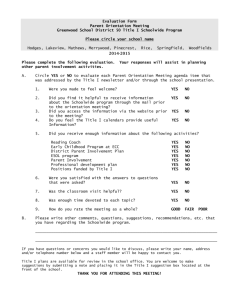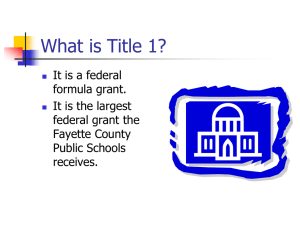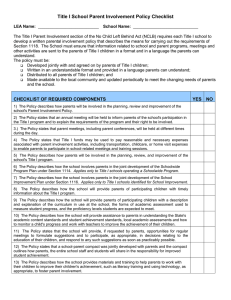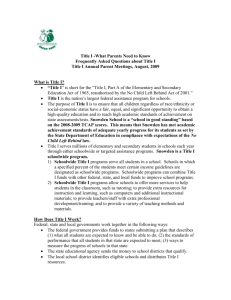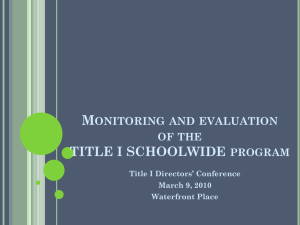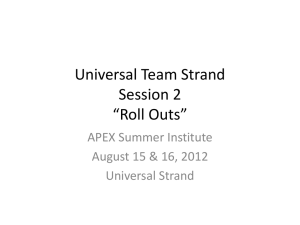Sky Ranch Title I Site Plan
advertisement
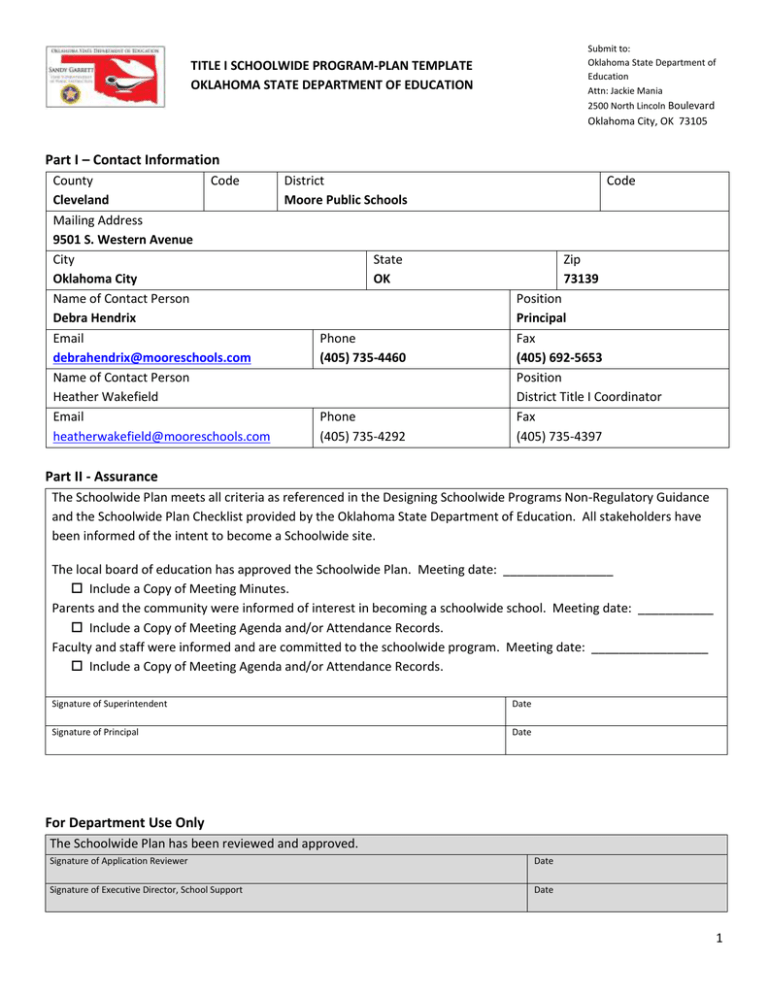
Submit to: Oklahoma State Department of Education Attn: Jackie Mania TITLE I SCHOOLWIDE PROGRAM-PLAN TEMPLATE OKLAHOMA STATE DEPARTMENT OF EDUCATION 2500 North Lincoln Boulevard Oklahoma City, OK 73105 Part I – Contact Information County Code District Cleveland Moore Public Schools Mailing Address 9501 S. Western Avenue City State Oklahoma City OK Name of Contact Person Debra Hendrix Email Phone debrahendrix@mooreschools.com (405) 735-4460 Name of Contact Person Heather Wakefield Email Phone heatherwakefield@mooreschools.com (405) 735-4292 Code Zip 73139 Position Principal Fax (405) 692-5653 Position District Title I Coordinator Fax (405) 735-4397 Part II - Assurance The Schoolwide Plan meets all criteria as referenced in the Designing Schoolwide Programs Non-Regulatory Guidance and the Schoolwide Plan Checklist provided by the Oklahoma State Department of Education. All stakeholders have been informed of the intent to become a Schoolwide site. The local board of education has approved the Schoolwide Plan. Meeting date: ________________ Include a Copy of Meeting Minutes. Parents and the community were informed of interest in becoming a schoolwide school. Meeting date: ___________ Include a Copy of Meeting Agenda and/or Attendance Records. Faculty and staff were informed and are committed to the schoolwide program. Meeting date: _________________ Include a Copy of Meeting Agenda and/or Attendance Records. Signature of Superintendent Date Signature of Principal Date For Department Use Only The Schoolwide Plan has been reviewed and approved. Signature of Application Reviewer Date Signature of Executive Director, School Support Date 1 Part III – Schoolwide Program Planning Team Section 1114 (b)(2)(B) of Title I requires that the plan be developed with the involvement of parents and other members of the community to be served and individuals who will carry out the plan, including teachers, principals and administrators, and, if appropriate, pupil services personnel, technical assistance providers, school staff, and if the plan relates to secondary school, students from such schools. Section A – Core Planning Team Name Heather Wakefield Title Title I Coordinator Stakeholder Group Administrator Debra Hendrix Principal Administrator Stephanie Gunter Assistant Principal Administrator Beth Lopez Title I Teacher Teacher Kristin Tupper Literacy Coach Teacher Sheila Cockerill Kindergarten Teacher Teacher Julie Robinson 1st Grade Teacher Teacher nd Katie Taliaferro 2 Grade Teacher Teacher Jennifer Seitsinger Rhonda Houdmann Julie Hayes Tammy Patrick Paige Hennen 3rd Grade Teacher 4th Grade Teacher 5th Grade Teacher 6th Grade Teacher Parent Teacher Teacher Teacher Teacher Parent Briefly describe how core planning team members were selected and how members of the school and community not on the core planning team will be involved in the implementation and evaluation of the Schoolwide Plan. Representatives from each grade level were asked to serve on this committee along with parents and administrators. Team members worked in pairs to review sections of the document and making any suggestions that would lead to increased student performance. Parents were asked for their input about perceived strengths and weaknesses of our programs. Together we reviewed the surveys that we were going to send out to parents and the needs assessment form. Section B – Technical Assistance Provider Name of Provider Mary Pearson Address 2500 N. Lincoln Blvd. Email marypearson@sed.state.ok.us Organization State Department of Education City Oklahoma City State OK Zip 73105-4599 Phone (405) 522-3253 2 Briefly describe technical assistance provided during the planning process and technical assistance planned for the implementation year. We did not contact Ms. Pearson for assistance this year. Part IV – Introduction Section A – Overview Provide a one page overview of your school and community including demographic data and poverty rate. Sky Ranch Elementary School is a pre-kindergarten through 6th grade school that was established in 1968. It is located in Cleveland County and is part of the Moore Public School system. Sky Ranch Elementary was a targeted assistance Title school for 23 years before becoming a schoolwide Title I school during the 2008-2009 school year. Current enrollment is 642 students. 61.8% of our students participate in the free or reduced lunch program. This is a decrease from 62.3% for the 2012-2013 school year. Many of our students live in the Brookwood Village Apartments, across the street from the school, which is a section eight, low income complex. 13.0% of our students do not complete a full academic year at Sky Ranch. We have a diverse student population. 6.2% of our students are English language learners. Many of their parents are not fluent in English and I many of their homes English is not spoken. The student enrollment by ethnicity is as follows: Black – 11.0%, American Indian – 4.0%, Hispanic – 23.8%, Asian/Pacific Islander – 3.8%, White – 41.4% Section B – Mission Statement A mission statement answers the question, Why do we exist? Provide the mission statement for your school. Sky Ranch Elementary School will provide opportunities to assist all students achieve academic and technological success as they strive to become lifelong learners. Section C – Vision Statement A vision statement answers the question, What must we do accomplish our mission? Provide the vision statement for your school. Sky Ranch will succeed in our mission by using strategic planning, collaboration, predictable remediation, providing extra time, and utilizing community resources. Section D – Data Reference Chart Provide the most recent information available. 3 Grade Span Average Attendance (Percentage) PK-6 94.0% Total Enrollment Free/Reduced Lunch (Percentage) 642 61.8% Special Education (Percentage) 14% ELL (Percentage) 6.2% Number of Certified Staff 36 Student Teacher Ratio District Report Card Grade D K-3 4-6 24/1 28/1 Section E – Documentation Please provide the copies of the following documentation with your Schoolwide Plan. Disaggregated test data for Math and Reading/Language Arts. Student/Parent/Teacher surveys (if applicable). Any additional student achievement data used in needs assessment (i.e., OCCT data, benchmark assessments, IEP referral data) Part IV Addendum – Data Profile 1. Student Enrollment by Gender Year Total Enrollment # Male % Male # Female % Female 2014-2015 2013-2014 2012-2013 664 642 554 337 342 314 51% 53.3% 56.7% 327 300 240 49% 46.7% 43.3% 2011-2012 574 227 48.2% 297 51.7% 2. Student Enrollment by Ethnicity Year Total Enrollment % Black % American Indian % Hispanic % Asian/ Pacific Islander % White % Other 2014-2015 664 10% 3% 27% 3% 41% 16% 2013-2014 642 11% 4% 23.8% 3.8% 41.4% 16% 2012-2013 554 11.4% 3.8% 22.7% 6.1% 48.9% 14.3% 2011-2012 574 7.8% 5.9% 20.9% 4.3% 55.9% None 3. Students Eligible for Free and Reduced Lunch Program Year Number 2014-2015 413 2013-2014 397 2012-2013 345 2011-2012 378 4. Students Participating in Targeted Title I Programs Year Program Enrollment Percent of Population 62% 61.8% 62.3% 65.97% Percent of Population 2014-2015 0 School-wide program 2013-2014 0 School-wide program 4 2012-2013 0 School-wide program 2011-2012 0 School-wide program 5. Student Attendance Average Daily Attendance Year Percent of Student Population # Male % Male # Female % Female 2014-2015 2013-2014 2012-2013 621.89 604 562.44 94.73% 94% 95.5% 314.23 322 330 51% 53.3% 52.8% 307.66 282 295 49% 46.7% 47.2% 2011-2012 545.8 95.8% 262.4 48% 283.4 52% 6. Student Tardy Rate Average Daily Tardies Year Percent of Student Population # Male % Male # Female % Female 2014-2015 2013-2014 2012-2013 6 6 9.8 0.8% 39.6% 1.77% 150 170 254 20.4% 23.4% 55.7% 133 118 202 18.1% 16.3% 43.3% 2011-2012 5.1 22.4% 69 53.5% 60 45.6% 7. Student Mobility Rate Full Academic Year (FAY) Year # Students Non Full Academic Year (NFAY) % Student Population # Students % Student Population 2014-2015 679 92.5% 55 7.5% 2013-2014 652 87% 94 13% 2012-2013 523 75.7% 168 24.3% 2011-2012 512 77.5% 149 22.5% 8. Student Truancy Rate Year 2014-2015 2013-2014 2012-2013 2011-2012 Average Daily Truancy 1 1 1 Percent of Student Population 0.1% 0.1% 0.1% 9. Students Identified as English Language Learners (ELL) Year 2014-2015 2013-2014 2012-2013 Program Enrollment 27 40 31 Percent of Student Population 4% 6.2% 5.6% 5 2011-2012 26 4.5% 10. Student Behavior Year Average Daily Referrals Average Daily In-School Suspensions Average Daily Out-of-School Suspensions 2014-2015 2013-2014 3.7 Referrals per day 1.2 Students in ISS/day(August-May) 1.8 Students on OSS per day(August-May) 2012-2013 2011-2012 1 (8 months) 1 (8 months) 22 (8 months) 20 (8 months) 23 (8 months) 22 (8 months) Part V – Needs Assessment Section 1114(b)(2)(B) of Title I of ESEA requires eligible schools that want to operate a Schoolwide Program to conduct a needs assessment to develop their Schoolwide Plan. Section A – Overview Briefly describe how the comprehensive needs assessment was conducted and how it addresses the needs of all students. The needs assessment survey forms were developed using various samples from other schools as well as previous surveys from Sky Ranch. The committee then reviewed them and copies were sent home. 177 Parent Surveys were returned. The survey asks parents about their perceptions of the effectiveness of the Title I program. They are asked about the communication between school and home and what programs and materials are effective. The results of this assessment guide the committee in developing the plans for the new year. Briefly describe how the data was analyzed and the actual results of your needs assessment. The surveys were tabulated and discussed at the Spring Site Based Committee. The surveys indicate that parents feel that reading is the highest priority to be served by Title I, followed by math and then technology. 100% of the parents surveyed believed that the Title I program has helped their child. Teachers, parents, and students also expressed a need for technology implementation to continue. The needs assessment along with the tabulation is attached. Section B – Goals As a result of the needs assessment, summarize the areas of strengths and weaknesses and identify the focus goals of the schoolwide program. Reading: 6 Strengths: Based on OAS Data: o 3rd grade – analysis & evaluation, vocabulary o 4th grade – figurative language, literal understanding o 5th grade – literal understanding, literary genre o 6th grade – accessing information, summary & generalization Based on Feedback from Teacher, Parent and Student Surveys: o Accelerated Reader Program o Parent Involvement Activities o Use of Technology such as: computers, computer games, document cameras and SMARTboards Areas of Improvement: Based on OAS Data: o 3rd grade – literal understanding, inferences & interpretation o 4th grade – literary elements, summary & generalizations o 5th grade – synonyms, antonyms, homonyms o 6th grade – word origins Based on Feedback from Teacher, Parent and Student Surveys: Math: Strengths: Based on OAS Data: o 3rd grade – algebra patterns/equations, number operations o 4th grade – number sense, lines/angles o 5th grade – number sense, data analysis o 6th grade – number sense, number properties, solving equations Based on Feedback from Teacher, Parent and Student Surveys: o Use of technology such as: Computers, Computer Games, and SMARTboards Areas of Improvement: Based on OAS Data: o 3rd grade – properties of shapes/spatial reasoning, measurement o 4th grade – number operations o 5th grade – measurement, algebra patterns o 6th grade – circles, coordinate geometry Based on Feedback from Teacher, Parent and Student Surveys: o Lack of quality hands-on teaching materials and resources Technology: Strengths: Use of technology such as: Computers, Computer Games, and SMARTboards, document cameras Areas of Improvement Teachers need additional and/or continuing Professional Development on how to effectively utilize technology in the reading and math classrooms Parent Portal 7 Parent Involvement: Strengths: More parents attended lower grade family nights than In the past Parents are willing to help when approached personally Areas of Improvement: Parents are needed to participate with their students in family nights in the upper grades Parents ensuring that homework is completed at home and returned the next day Parents participating in PTA Parents helping facilitate open communication with teachers and administration Focus Goals: 1. Reading – In 2015-2016, 80% of students in grades 3-6 will score advanced or satisfactory on the Reading/ELA OAS. 2. Mathematics – In 2015-2016, 80% of students in grades 3-6 will score advanced or satisfactory on the Math OAS. 3. Technology – In 2015-2016, all K-6 Reading/L.A. and Math classrooms will strive to utilize and increase technology including but not limited to ipads, smartboards, computer labs and document cameras at least twice a week as documented by administrative walkthroughs and evaluations based on conversation with administrators and lesson plan checks. 4. Parent Involvement – In 2015-2016, the number of parents/family members attending Title I sponsored activities will increase by 10% as identified by the sign-in sheets from each activity. Section C – Documentation For each of the identified focus goals, include the following information in your Schoolwide Plan: Part V Addendum - Schoolwide Focus Goal Action Plan for Each Identified Goal Part V Addendum – Schoolwide Focus Goals For each focus goal identified in Part V of the Schoolwide Plan, complete a Schoolwide Focus Goal Action Plan. Goal: Reading – Increase student achievement across grade levels in reading. Briefly describe the reasoning for the identified goal. The areas where our students consistently scored well below 80% on the reading OCCT in 3rd grade were literal understanding, inferences & interpretation; 4th grade are literary elements, summary & generalization; 5th grade are synonyms, antonyms, homonyms; 6th grade are word origins. Focusing on these areas of need will help our students become better readers by improving their knowledge and skills. Describe the measurable outcomes for the goal (i.e., In 2009-2010, the percentage of students scoring 70 or below on the quarterly math assessment will decrease by 10%) In 2015-2016, 80% of students in grades 3-6 will score advanced or satisfactory on the Reading/ELA OCCT. Action Plan 8 Strategies and Action Steps Title I Tutoring K – 6th grades Resources Needed Funding to pay tutors, tutors, materials Person(s) Responsible Title I Teacher, teachers, administrators Administrators, classroom teachers, computer lab teacher Timeline Evidence of Progress October-April Improved reading grades and test scores Ongoing – all school year (minimum of 2 sessions/week) Improved reading grades and test scores; Improved performance on DIBELS Think Through Math Think Through Math Software Accelerated Reader (AR) Comprehension AR program; Media center support; classroom computers Title I Funds for materials, refreshments, etc., principal and teachers’ support Manipulatives and other Resources, SMART boards, teacher training Administrators, classroom teachers, AR committee Title I Teacher, teachers, administrators Ongoing – all school year Increase % of comprehension rate At least once per year Classroom teachers Ongoing-all school year Increase Awareness of the importance of reading support and the home-school relationship Increase reading grades and test scores Study Island software Administrators and classroom teachers Ongoing – all school year Increased reading grades and test scores Family Reading Night Increase Hands-on Learning Study Island computer program Reading Goal: Math – Increase math achievement across grade levels Briefly describe the reasoning for the identified goal. The areas where our students consistently scored well below 80% on the math OAS in 3rd grade were properties of shapes/spatial reasoning, measurement; 4th grade were Number Operations; 5th grade were measurement, algebra patterns; 6th grade were circles, coordinate geometry. It is believed that focusing more attention on increased instruction, tutoring, and materials/resources in the above named areas will allow for our students to improve their knowledge and skills. Describe the measurable outcomes for the goal (i.e., In 2009-2010, the percentage of students scoring 70 or below on the quarterly math assessment will decrease by 10%) In 2015-2016, 80% of students in grades 3-6 will score advanced or satisfactory on the Math OCCT. Action Plan Strategies and Action Steps Title I Tutoring K – 6th grade Resources Needed Funding to pay tutors, tutors, materials Person(s) Responsible Title I Teacher, teachers, administrators Timeline Evidence of Progress September -April Improved math grades and test scores 9 Family Math Night Increased Hands-on Learning Study Island computer program Title I Funds for Title I Teacher materials, refreshments, etc., principal and teachers’ support Manipulatives and Classroom teachers other Resources, SMART boards, teacher training Study Island software Administrators and classroom teachers At least once per school year Ongoing-all school year Increase Awareness of the importance of math support and the home-school relationship Increase math grades and test scores Ongoing – all school year Increased reading grades and test scores Goal: Technology – Our goal for the 2015-2016 school year is to continue to acquire technology and provide on-going Professional Development on how to effectively utilize that technology in the reading and math classrooms. Briefly describe the reasoning for the identified goal. Increasing instructional technology and improving the current technology at our site would allow for teachers to improve classroom learning in reading and math by broadening our range of teacher tools and would allow teachers to increase the amount of time students spend using our individualized programs. Feedback from surveys also showed a need in technology support. Describe the measurable outcomes for the goal (i.e., In 2009-2010, the percentage of students scoring 70 or below on the quarterly math assessment will decrease by 10%) In 2015-2016, all K-6 Reading/L.A. and math classrooms will strive to utilize and increase technology including but not limited to ipads, smartboards, computer labs and document cameras at least twice a week as documented by administrative walkthroughs and evaluations based on conversation with administrators and lesson plan checks. Action Plan Strategies and Action Steps Increase Hands-on Learning Resources Needed Technology Training for Teachers SMART boards, LCD projectors, document cameras Trainer, Stipend for attendees Study Island Computer Program for 3-6th grades Study Island Online subscription Person(s) Responsible Classroom teachers Resources Needed Ongoing-all school year Site Tech, Administrators, and classroom teachers Ongoing-as needed and when new programs and hardware are added Administrators and classroom teachers Ongoing-all school year Person(s) Responsible Increase reading and math grades and test scores Increase use in class, students are more engaged thus increasing reading and math grades and scores Improved reading grades and test scores 10 Reading Reading Eggs Computer Program for 1-2 grade Think Through Math Reading Eggs Online subscription Administrators and classroom teachers Ongoing-all school year Improved reading and math grades and test scores Think Through Math online subscription Administrators and classroom teachers Ongoing-all school year Improved math grades and test scores Goal: Parent Involvement – Our goal for the 2015-2016 school year is for parents to become more involved in PTA, attend Family Nights with their students, help keep ongoing communication with teachers and help ensure that homework is being completed and returned to school. Briefly describe the reasoning for the identified goal. A growing body of research shows that successful parent involvement improves not only student behavior and attendance but also positively affects student achievement. Sky Ranch has difficulty getting parents involved in their students’ success. We would like to provide a receptive atmosphere that makes parents feel welcome. Describe the measurable outcomes for the goal (i.e., In 2009-2010, the percentage of students scoring 70 or below on the quarterly math assessment will decrease by 10%) In 2015-2016, the number of parents/family members attending Title I sponsored activities will increase by 10% as identified by the sign-in sheets from each activity. Action Plan Strategies and Action Steps Family Reading/Math Night; Reading Fair; Kindergarten Transition Night Book Fair Related Activities – (Doughnuts for Dads; Muffins for Moms) Parent University – Reading and Math Resources Needed Title I Funds for materials, refreshments, etc., principal and teachers’ support Title I funds for materials, refreshments, etc., principal and teachers’ support Title I funds for materials, refreshments, etc., principal and teachers’ support Person(s) Responsible Title I Teacher Grade Level Teachers Timeline Evidence of Progress At least one time per school year Increase Awareness of the importance of reading support and the home-school relationship Increase Awareness of the importance of reading support and the home-school relationship Increase Awareness of the importance of reading support and the home-school relationship Title I Teacher Grade Level Teachers Media Specialist At least one time per school year Title I Teacher Grade Level Teachers At least one time per school year Part VI – Schoolwide Reform Strategies 11 Instructional strategies and initiatives in the comprehensive plan must be based on scientifically based research, strengthen the core academic program, increase the quality and quantity of learning time and address the learning needs of all students in the school. Section A - Scientifically Based Research (SBR) List the SBR instructional strategies that will be implemented. Explain how they will be utilized in the classroom and how they will be evaluated for effectiveness. Accelerated Reader – A reading assessment program used to determine a students’ individual zone of proximal development. The student’s goal is set at the beginning of each quarter. The student, teacher, and parents work together to select interesting and motivational literature based on the reading level to enhance reading instruction and practice. Students take a quiz on the computer upon completing each book to assess comprehension. Each classroom teacher monitors their individual students’ progress. Once students have shown continued success at their current reading level, their reading level is increased. Success Maker Reading and Math – A software program that allows students to review and develop their skills in reading and math. Students’ progress through the levels as each skill is mastered. A computer generated report can be printed allowing teachers to track and make accommodations for their students and showing areas where reteaching are necessary. Technology – Increasing the amount of the amount of technology in the classroom will allow our teachers to have a wider variety of resources to use when teaching and reviewing reading and math skills and concepts. Using technology also allows for teachers to engage students for longer periods of time and present information in a new and exciting manner. Tutoring – Allow for individual and/or small group intervention; focuses intense instruction on specific skills in relation to math and reading. Allows for re-teaching and practice at a slower pace until mastery is reached. Hands-On Learning – Engages and motivates students to become actively involved in the learning experience. Promotes higher level thinking and encourages students to manipulate and experiment with learning in reading and math. Textbooks – Systematic approach to teaching math and reading. Lessons are correlated to Oklahoma PASS Skills and provide for whole class/small group instruction by the teacher and independent student centered application and practice of learned skills. Section B – Extended Day/Extended Year Explain the extended day/extended year program to be implemented. Include procedures for monitoring and evaluating the program. Before and After School Tutoring - We will provide before and after school tutoring the month preceding state testing . Students’ progress will be traced through the use of the Success Maker program. We would like to see a mixture of computer based and teacher/small group tutoring this next year. Progress is monitored by the teacher through 9 weeks test scores and daily work. Teachers recommend summer school for students who still need help after the regular school year has ended. Evaluation of OCCT test scores in the fall will provide documentation of student success. Section C – Core Academics 12 Explain how the school reform strategies will strengthen the core academics (reading and math programs) of the school. Our identified goals are specific to the areas of reading and math. Technology and parental involvement support both of these areas. Tutoring and Saturday School will increase support opportunities for the students in both reading and math. Computer programs focused on remediating and reinforcing students’ reading and math skills will increase students’ knowledge in those areas. Increasing opportunities for our parents to become involved in their students learning through family nights will in turn improve students’ motivation and engagement in reading and math. Increasing hands-on learning will engage and motivate students to become actively involved in the learning experience and promotes higher level learning. Finally, providing teachers with professional development opportunities in regards to reading and math, as well as using technology in the classroom, will help ensure that new methods of instruction are being implemented to encourage optimal learning opportunities for students in reading and math instruction. Section D – Curriculum Alignment Explain how curriculum is aligned with PASS at the school. The curriculum in all Moore Schools follows curriculum maps developed by all academic coordinators to align with the OAS objectives. Teachers use the curriculum guides to help them plan instruction and prepare their students for end of quarter testing and state standardized testing. Section E – Technology Explain the usage of technology at the school to improve student engagement and achievement. How is it being monitored and evaluated for effectiveness? Accelerated Reader, Study Island (3-6) Reading, Reading Eggs (1-2), Think Through Math (3-6) and STAR programs have been implemented in our school. These programs allow teachers to successfully track student progress and plan instruction for weak areas. Reports from these programs also allow us to communicate more effectively with parents. SMART Boards and document cameras have been installed in all reading/math classrooms allowing the students the opportunity to do more interactive learning. Students are actively engaged with the lessons. Evaluation is done through analyzing reading and math grades and test scores. Redcat audio systems have been put in place to ensure that every child in the classroom is able to very clearly hear the teacher no matter where they are in the room. Section F – Meeting the Needs of Students 13 Explain how the schoolwide reform strategies will address the needs of all children in the school, particularly the needs of low achieving students and historically underserved populations. Coordination of the specialists with the classroom teachers and the counselor helps us meet the needs of low achieving students: Additional help in class One-on-one instruction where needed Frequent assessment Tutoring before and after school Coordination of services Outreach to parents Part VII – Instruction by Highly Qualified Teachers A highly qualified teacher (HQT) must hold a minimum of a bachelor’s degree; and obtained full Oklahoma certification or licensure; and has demonstrated competency in each of the academic subjects in which the teacher delivers content knowledge. A highly qualified paraprofessional must have completed at least two years of study at an institution of higher education; obtained at least an associate’s degree; or passed the Oklahoma General Education Test or another academic assessment approved by the Oklahoma State Board of Education. Section A – Highly Qualified Teachers (HQT) and Paraprofessionals Number of Certified Teachers Number of HQT Number of Non HQT 0 Number of Paraprofessionals Number of HQT Paraprofessionals Number of Non HQT Paraprofessionals 0 Section B – Teaching Experience Years of Experience Number of Certified Teachers 0-3 3-5 6-10 11-15 15-20 20+ Doctorate National Board Certification Section C – Education Degree Received Number of Certified Teachers Bachelor’s Bachelor’s + 15 Master’s Master’s +15 Section D – Action Plan 14 Briefly describe the action plan for ensuring all students are taught by Highly Qualified Teachers specifically addressing any current Non-Highly Qualified Teachers at the site. All teachers at Sky Ranch Elementary are all highly qualified. No changes are necessary. Only highly qualified teachers will be employed in the future. Section E – Documentation Include the copies of the following documentation in the Schoolwide Plan: Letter of Notification to Parents of Students Taught by Highly Qualified Teachers Part VIII – Professional Development High quality professional development focuses on improving student achievement by elevating teacher and principal quality through scientifically based researched strategies. All professional development must support the goals of the schoolwide program. Section A – Development and Evaluation Describe how the yearly professional development plan is created and who is involved in the decision making process. The professional development committee develops a plan which is aligned with the needs expressed by our teachers and staff. This plan also fulfills the criteria set forth by district, state, and federal guidelines. The plan is designed to help us meet our focus goals. Describe the procedures that are in place for follow-up on each professional development activity. Participants are asked to complete an evaluation to determine strengths and weaknesses of the presenter and/or workshop following each professional development activity. These results are given to the presenter for review in order to improve and refine the professional development for the future. Do staff members have individual professional development plans? Explain how the plans are created and how the staff is supported by the school in reaching these goals. Staff members have professional development plans that are grade and department specific. There are district, state, and federal guidelines that must be met. The school offers professional development opportunities which help ensure each teacher completes their plan. Describe how professional development supports the Schoolwide Plan and Schoolwide Focus Goals identified in Part V. Training in the operation and use of the SMARTboards and document cameras for effective instruction is ongoing in the district and in our school. Teachers were able to attend a variety of workshops and trainings this year in reading and math teaching strategies to help us meet that goal. Section B – Documentation Include the following documentation in the Schoolwide Plan: Professional Development Plans for the current year and the implementation year Sample copies of Agendas and Attendance Records for Professional Development 15 Sample Evaluation Tool for Monitoring the Implementation of Professional Development Activities Sample Individual Professional Development Plan Created by Staff Part VIII Addendum – Professional Development Plan Complete one (1) professional development plan for the current year (planning year) and the following year (Implementation Year). For the Implementation year, please estimate dates and location and do not include number of participants. Year of Plan: 2015-2016 Professional Development Activity DIBELS New Teacher and Refresher Course Number of Participants Date(s) Aug 2014 9 Description (i.e., content, duration of time) 2 hour –MNTC – go over the "how to's" of the testing process and data management 6.75 hours – SR - review the OCCT test scores for 2012-2013 and then strategize how to improvie effective teaching, thus raising test scores for 2013-2014. 1.0 hours – SR - Review of SLB procedures and applications Test Scores Review and Planning 9/2/14 53 SLB Review 9/4/14 6 Various OTISS Meetings 8/25, 9/29, 10/21, 10/27, 12/9, 1/26, 3/2, 3/30, 4/27, varied 1 hour each – SR - Participants reviewed OTISS data, helped develop plan, updated plan Book Study: Small Group Reading Instruction 10/28, 11/4, 11/19, 12/8 12 1 hour each – SR– best practices in small group reading instruction From Drab to Fab 12/2 15 1 hour – SR – best practices in math to enhance instruction Grade Cam/Insight 2/17 8 1 hour – SR- ways to incorporate the grade can/insight into your classroom instruction Using Ipads in your classroom to remediate students Fall 2015 Sky Ranch Best practices for using the smartboard in your classroom Fall 2015 Sky Ranch Horizontal Team Meetings Fall 2014 Sky Ranch 16 DIBELS New Teacher and Refresher Course Fall 2014 Metro Tech Book Study – Differentiated Instruction?? Fall 2014 Sky Ranch Book Study – Reading and Writing Strategies??? Spring 2014 Sky Ranch Vertical Team Meetings Fall/Spring 2014 Sky Ranch Part IX – High Quality Teachers to High Need Schools The Schoolwide Plan must describe the strategies it will use to attract and retain highly qualified teachers. Section A – Teacher Turnover Rate Year 2014-2015 2013-2014 2012-2013 2010-2011 Number of Returning Teachers 26 27 26 31 Number of New Teachers 10 9 10 5 Percentage of Turnover 28% 25% 28% 16% Section B – Recruitment Describe the recruitment plan to attract highly qualified teachers including specific details about partnerships with institutions of higher education and neighboring school districts. The district of Moore Public Schools maintains a district-wide strategy of recruiting highly qualified teachers by maintaining an impeccable reputation as a highly desirable place to teach/work, and being a highly desirable district in which to live. Teachers’ salaries are above the state minimum and among the highest in the metro area. The administrator attends a yearly job fair that the district sponsors in an attempt to identify and interview highly qualified applicants. When an interview is conducted outside of the job fair setting, a panel of teachers participates in the interview and serves as an active part of the decision making. Section C – Retention 17 Describe the teacher support system of the school including specific details about mentoring, collaborative teams, inclusion in decision making and encouragement to continue higher education or pursue National Board Certification. Entry year teachers are assigned a mentor teacher to assist them during the year. They meet on a regular basis so the entry year teacher has support. Grade levels meet each week to make decisions regarding instruction and to deal with any problems that may arise with students. Grade levels all have the same planning periods to enable them to plan together. Part X – Parental Involvement Section A – Design, Implementation and Evaluation of the Schoolwide Program Explain how parents were involved in the in the planning year and the needs assessment process and how parents will be involved in the implementation of the Schoolwide Plan. The Title I program at Sky Ranch Elementary strives to provide an opportunity for parents to become actively involved with their child’s education in a variety of ways. Needs assessments are sent to all parents at the end of each year and parents are invited to participate in planning meetings to discuss the results. Parent involvement programs are planned based on the parents’ requests and the needs assessments. Parents are asked to review the programs in order to improve the next event. Section B – Communication Describe how information will be communicated between school and parents and families including information about parent meetings, specifically the required Annual Parent Informational Meeting. Communication between school and home is critical. The Title I teacher at Sky Ranch notifies the faculty and families of all upcoming meetings and activities through emails, school website, electronic phone system, Thursday folders, the Sky Ranch marquee and monthly newsletters. Other ways parents receive information include Back-to-School night, district, school and teacher websites, parent/teacher conferences, report cards and progress reports, as well as the school wide parent information meeting in the fall. Section C – Parent Involvement Activities 18 List and describe current parental involvement activities and how data about activities is collected and evaluated. Author, Darleen Bailey Beard, provided a writing workshop for the 4th and 5th grade students during the day. She returned that evening for a Parent Writing Workshop in conjunction with the Fall Book Fair. PreK-3rd Grade Reading Fair was held in conjunction with the Spring Book Fair. PreK-2nd grade classes each created reading boards covering their favorite books. Third grade had each student prepare a reading board. All boards were displayed in the cafeteria for parents to observe. 4th -6th Grade Reading Fair was held right before spring break. Every student was to create a reading board to be displayed for the parents. A parent/student work night was held. Materials were available to help with creating the boards as well as the computer lab open for printing and/or research. Kindergarten Transition Night was held in late May. Materials will be provided for the parents to work with the students over the summer to help them be more prepared for kindergarten. Parents were asked to assess the effectiveness of these programs on the parent survey. Section D – Services List and describe services that will be provided to parents as part of the Schoolwide Plan. Parent resource center located in the media center that provides resources to help parents work with their students on academics as well as behavior. Camp Mustang: Before and after school care Parent Workshops will be made available centered around activities that will allow parents to work with their children to improve specific reading and math skills. Section E – Documentation At a minimum, Schoolwide Plans MUST include the following documents: Copy of the Site Parent Involvement Policy Copy of the Site Parent/School Compact Copy of Notification to Parents of the Annual Parent Informational Meeting Agenda and Attendance List for the Annual Parent Informational Meeting Parent Survey or Other Evaluation Tool Regarding Parent Involvement Activities Examples of School/Parent Communication Copy of Notification to Parents Regarding Student Achievement Reports and Test Scores Copy of Notification of Title I Programs and Opportunities Part XI – Transition Strategies Activities are encouraged at the critical transition grades to support the students and parents with curriculum, instruction and procedural changes. Section A – Identifying Transition Points Transition From home or daycare to Grade(s) Affected Kindergarten Transition Strategies/Activities -Calls from the teacher Timeline August 19 school ½ day Kindergarten to full day first grade Self-contained 3rd grade to departmentalized 4th Kindergarten Elementary to Junior High 6th grade Pre-K/Daycare/Home to Kindergarten PreK-Kinder 3rd grade -Back-to-School Night -Communication: Daily folder, phone calls and conferences -Parent Night Back-to-School Night Lunch at school -Visits with 4th grade classrooms -Teach organizational skills -Follow some of the same procedures as fourth grade -Visit to the Junior High -Practice with combination locks -Practice junior high schedule Kindergarten Transition Night May May May May Section B – Overview Describe the activities that support the transition strategies. Explain how all stakeholders (counselors, school staff, parents, students) are involved in the activities. Parents of the new Kindergarten students are strongly encouraged to attend “Back-to-School Night” with their students prior to the beginning of school. This event provides an opportunity to meet the teacher, unpack student supplies and acclimate the child to the classroom environment. The kindergarten parent meetings are held shortly after school starts to provide further information and address any concerns. Additional parent nights and programs are scheduled to keep parents involved and informed of student progress. A weekly parent letter is provided to make parents aware of what children are learning and experiencing. Kindergarten students are gradually given more opportunities for growth and responsibility as the year progresses. One example of this is the Tuesday reading homework folder that is implemented during the second semester in addition to the Thursday homework folder that begins shortly after school begins. Our half-day kindergarten students are provided the experience of eating lunch in the cafeteria towards the end of the school year to prepare them for that part of being in school all day in first grade. Grade levels 1-6 provide parent communication and meetings so that teachers have the opportunity to make parents and students aware of expectations and progress. As students move from 6th grade to Junior High School, they go on a field trip to the Junior High they will be attending. There they meet with counselors to learn enrollment procedures, choices for electives, and expectations of the school. The students are also given a tour of the school. Here at Sky Ranch, the counselor sets up a mock junior high schedule so the students can practice getting from classroom to classroom in only five minutes. They also practice opening combination locks to help relieve some of that stress. Section C – Documentation Include the following documentation in the Schoolwide Plan: Copies of letters, flyers, and/or mailings notifying parents of transition activities Attendance records of parent meetings regarding transitions Evidence of vertical teaming among faculty (i.e.-agendas, minutes, curriculum maps) Part XII – Data-Driven Decisions The Schoolwide Plan should provide teachers with professional development that increases their understanding of the appropriate uses of multiple assessment measures and how to use assessment results to improve instruction. 20 Section A – Assessments Assessment Timeline DIBELS 3 times a year plus progress monitoring each month Gates-MacGinitie Reading Test Fall and Spring District Curriculum Tests Every 9 weeks STAR Reading Test Ongoing throughout the year Every April OAS AR COGAT Ongoing throughout the year Beginning of second semester Purpose To assess student progress toward Benchmarks in the following areas: Phonemic Awareness, Alphabetic Principle, Accuracy and Fluency, Vocabulary and Comprehension. Assessed K-3rd grades Used as a pre and post reading test to assess progress in vocabulary and comprehension. Assessed in 4th-6th grades Used to determine direction that instruction should take and to assess student progress To determine students’ independent and instructional reading levels To measure student progress and guide our modification of current practice to improve student achievement To help teachers progress monitor and measure students’ reading comprehension Given to students in 2nd and 6th grade for identification purposes in special programs such as the Gifted and Talented Program (SEARCH) and/or Special Education. Section B – Overview Briefly describe the key assessments used by the school site, the procedure for sharing the data, and how teachers are using this data to make decisions for improving student learning (i.e., OCCT data, benchmark data). Reading and math assessments used at Sky Ranch include DIBELS, Gates-MacGinitie and OAS. The DIBELS benchmark assessment is a reading assessment used to assess students in the following areas: Phonemic Awareness, Phonics, Vocabulary, Comprehension, and Fluency. It is used with students from Kindergarten to 3rd grade. It is given three times a year by the classroom teacher. Ongoing progress monitoring is used for those students who fall in the intensive or strategic ranges. This ongoing information helps teachers modify instruction to teach specific skills to develop these students reading skills. Reports are regularly sent home to parents. The Gates-MacGinitie Reading Test is given in the fall and spring to students in the 4-6th grade. The test given in the fall is used as a pretest to provide information to the classroom teacher in regard to each student’s comprehension and vocabulary skills/level. The posttest is given in the spring. The two scores are compared which allows the teacher to see gains made by the students in comprehension and vocabulary. The OAS is given in mid-April to students in grades 3-6. Teachers analyze the results from the previous year to evaluate the strengths and weaknesses of their teaching and their students’ learning. Teachers use this information to focus instruction on the areas of weaknesses demonstrated on the test and modify their instructional approaches to increase their students’ learning. Section C – Evaluation 21 Explain how assessments and data-driven decisions are evaluated for effectiveness. Student progress is continually monitored. Teachers observe students through their work and participation in class. Teachers use a variety of informal assessments such as the Dolch word lists, 9-week tests, checklists, rubrics, report card assessments, as well as the reports from the Success Maker, Study Island and Riverdeep programs. Results from the end of year surveys will help determine the success of the assessments and will guide decisions made regarding instruction and curriculum. Scores will be reviewed to determine success and guide future decision making in relation to instruction and curriculum in reading and math. Part XIII – Effective and Timely Additional Assistance Schoolwide schools must identify students who need additional learning time to meet standards and provide them with timely, additional assistance that is tailored to their needs. Section A – Overview Describe the additional assistance programs (intervention programs, extended day/year, math/reading blocks, tutoring) offered at the school. Low achieving students receive tutoring during the school day from the Title I teacher or assistant Low achieving students receive before/after school tutoring Students with limited English receive ELL tutoring Native American students can receive additional help from the Indian Tutor Student with speech difficulty receive help from the Speech Pathologist Summer School is offered to students to prepare them for the next grade level Students who are identified as Special Education students, receive instruction from a qualified special education teacher Section B – Procedure Explain the procedures in place to ensure students requiring additional assistance will be provided with effective, timely assistance. Classroom teachers who observe a student having difficulty in any areas described above will refer the student for the appropriate services. The Title I teacher monitors the DIBELS and Gates-MacGinitie scores. The teachers will refer students who are not on grade level to the Title I teacher for additional help. Parents are contacted and the decision to serve the child in the most beneficial way is made. 22 Section C – Evaluation Explain how intervention programs/services are evaluated for effectiveness. Effectiveness of the intervention program is made by monitoring the progress of the student. Multiple assessments are made and efforts are coordinated between the classroom teacher and the other parties involved such as the Title I teacher, the tutor, or the special teacher. Part XIV – Coordination of Programs Schoolwide schools are expected to integrate services and programs with the aim of upgrading the entire educational program and helping all students reach proficient and advanced levels of achievement. Section A – Overview Briefly describe how local, state and federal programs will be coordinated to support high-quality learning opportunities for all students in your school and how these programs are aligned to the Schoolwide goals. Students receive services based on their test scores and their classroom performance. Classroom teachers, special education teachers, the guidance counselor, speech and language pathologists, ELL teacher, Indian tutor, and the Title I teacher administer and analyze assessments in order to identify the needs of our students. The student’s progress is continually monitored and all parties communicate on a regular basis to track the effectiveness of instruction. Section B – Coordination of Effort Coordination of Effort Funding Source Federal/Title I (modifications made to align with schoolwide goals) Federal/Title III Program/Service Impacted Reading and Math Intervention Program Tutoring and Saturday School Training, recruitment, and retention of highly qualified teachers ELL Federal/Title IV Guidance Federal/Title Vii Indian Education/JOM Hire Certified Teacher, Purchase Supplemental Materials Violence Awareness and Drug Free Education for School and Community Hire Tutor, Purchase Supplemental Materials Federal/Special Education Local/Community Services Special Services Salaries and Supplemental Materials Complete Curriculum Enrichment Activities Federal/Title II Employ a Reading Specialist, Purchase Supplemental Materials, Hire Tutors Staff Development Part XV – Required Documentation 23 The following documents must be included in the complete Schoolwide Plan: Copy of Local Board of Education Meeting Minutes Reflecting Schoolwide Plan Approval Copy of Meeting Agenda and/or Attendance Records for Parent Informational Meeting Copy of Meeting Agenda and/or Attendance Records for Faculty Informational Meeting Disaggregated Test Data for Math and Reading/Language Arts Student/Parent/Teacher Surveys (if applicable) Additional Student Achievement Data Used in Needs Assessment Part IV Addendum – Data Profile Part V Addendum - Schoolwide Focus Goal Action Plan(s) Letter of Notification to Parents of Students Taught by Non Highly Qualified Teachers Part VIII Addendum - Professional Development Plans for the Current and Implementation Year Sample Copies of Professional Development Agendas and/or Attendance Records Sample Evaluation Tool for Monitoring the Implementation of Professional Development Activities Sample Individual Professional Development Plan Created by Staff Copy of Parent Involvement Policy Copy of Site Parent/School Compact Parent Survey or Other Evaluation Tool Regarding Parent Involvement Activities Examples of School/Parent Communication Copy of Notification to Parents Regarding Student Achievement Reports and Test Scores Copies of Notification to Parents of Annual Parent Informational Meeting Copies of Notification of Title I Programs and Opportunities Copies of Letters, Flyers, Mailings, etc. Notifying Parents of Transition Activities Attendance Records of Parent Meetings About Transition Activities Evidence of Vertical Teaming Among Faculty (i.e., Agendas, Minutes, Curriculum Maps) 24
